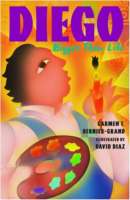
Diego Rivera’s energy, physique, love for women, and work were all “bigger than life.” Born in a small Mexican mining town in 1886,he drew his way through childhood, entered art school at ageten, and later traveled throughout Europe, studying the great masters andimitating their techniques. When he returned to Mexico in 1921, he foundhis own unique style. He began painting the poetry of the common people –working, suffering, fighting, seeking joy, living, and dying — on thewalls of public buildings. His murals were passionate, controversial, political,and enormous — like the painter himself.
- ISBN: 9780761453833
- Author: Bernier-Grand, Carmen T.
- Published: 2009, Marshall Cavendish Corp/Ccb
- Themes: Art and artists, History, Paintings, Poetry
- Descriptors: Biography - Autobiography- Memoir, Mexico, Young Adult (ages 14-18)
- No. of pages: 64

Ann
Diego: Bigger than Life, tells the story of “the charming, monstrous, caring, hideous Mexican muralist” (p. 4) Diego Rivera. Written in free verse, the artist warns us in the first page that he is a storyteller and chooses to embellish his own life story. Bernier-Grand admits in the endnotes that Diego embellished so much of his life that sometimes it was difficult to tell fact from fiction, but she chose to tell Diego’s story from his point of view. For example, in the verse entitled “Antonia the Healer” (p. 8) Diego talks about living with his Tarascan nurse, Antonia, in the sierra after the death of his brother. It was here where he claims he gained the strength he never had as a young child. According to other accounts, however, Diego may have visited the sierra often but probably did not live there.
In “Diego the Red” ( p. 42) Diego once again lets the reader know that perhaps he looks at the world differently. In describing how he left the Mexican Communist Party, he counters the party’s arguments with his own, claiming that he expelled himself, not that he was asked to leave.
Diego Rivera was an artist who was “bigger than life”, and I think Bernier-Grand captures that in this book. The spare writing encourages children to dig deeper into the life and times as well as the art of this brilliant, selfish, talented man. As I was reading, I felt that perhaps I was missing too much about his life and about the history and culture of Mexico, but the notes and chronology included at the end of the book helped to fill in some of those gaps, and Bernier Grand includes an entire bibliography of books for readers to continue to learn about Rivera.
Patricia
I mentioned to Ann that as we were figuring out how “our takes” may unfold, it pushed me to go back to think about my visit to Mexico City, 16 years ago. I looked at old photograph boxes and Frida’s blue house popped out and Diego’s amazing murals at the Ministry of Public Education in Mexico City. Can´t forget my visit to Leon Trotsky´s house who influenced both Frida´s and Diego´s lives.
Interesting how Bernier-Grand tells Diego´s story. Carefully unfolds his stories and highlights the most important, his contribution to the arts and the influences (political, economic…) that formed him as a person and artist. I enjoyed reading the book! I think it’s a challenge for the author to capture a story in free verse and agree with Ann that she had to dig deep to really illustrate Diego as an artist “bigger than life.” I also think that any reader will experience the desire to inquire more about Diego Rivera or as I experienced, the need to go back 16 years and enrich the reading experience. Fascinated by this aspect of the book.
Ann
I would love to visit Frida’s blue house and see some of Diego’s murals in Mexico City!
I enjoyed David Diaz’s illustrations for the book, especially how he carefully placed certain things in some of the illustrations to go along with the stories; you can spend time looking at the illustration to make sure you see everything. For example, in the verse entitled “On the Road to Becoming an Artist” (p. 14), Bernier-Grand mentions the frogs in Diego’s pockets, and the illustration has a frog in his pocket as well as several hopping around him. That verse also talks about La Catrina, the iconic skeleton lady who is dressed in fancy clothes. You have to look for a minute to see part of her image in the window that Diego is peering through. Diaz’s use of color and simple lines evoke Diego’s later work that captured the spirit of Mexico and its people. I also appreciate the use of some of Diego’s actual artwork; I think it is important when reading about an artist to be able to see some of his or her real work.
I liked this book too. I think the verse captures the multiple sides of a very complicated man, one who might be considered “monstrous” but who was also a true genius.
Patricia
I’m so glad that you mentioned the illustrator David Díaz. When I completed my previous take, I had the urge to mention that I´m used to his bright colors and that in this book I missed that. I wonder what his research process was on Mexican culture.